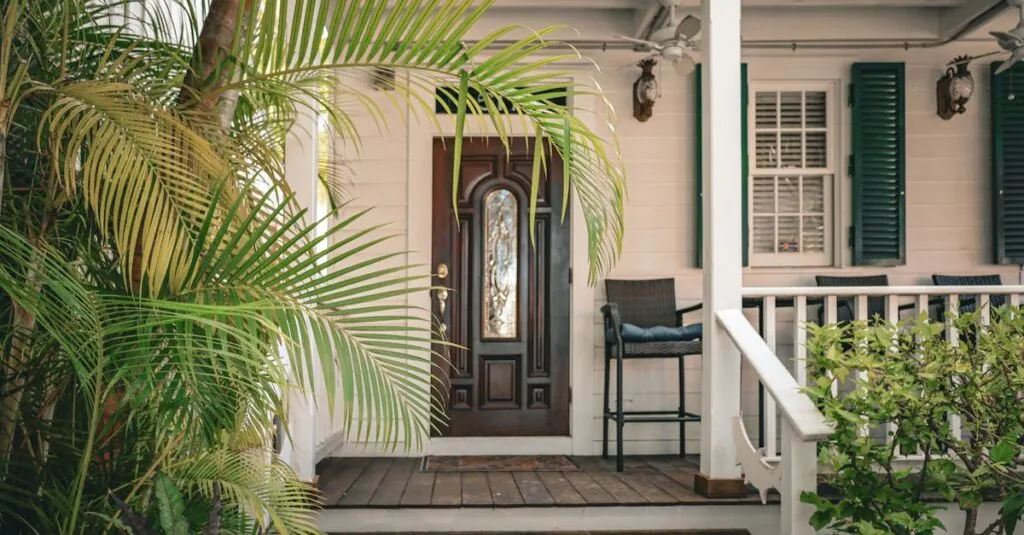Table of Contents
ToggleImagine sipping your morning coffee while basking in the gentle breeze, all without the fear of an unexpected rain shower ruining your day. Covered porches are the unsung heroes of outdoor living, offering a seamless blend of comfort and style. They provide a cozy retreat that invites relaxation and makes entertaining a breeze—literally!
Whether it’s a sunny afternoon or a drizzly evening, a covered porch transforms any weather into an opportunity for enjoyment. It’s the perfect spot for lazy afternoons, lively gatherings, or even a good book. So why not elevate your home’s charm and functionality with this delightful addition? Dive into the world of covered porches and discover how they can enhance your lifestyle while keeping you stylishly sheltered.
Overview of Covered Porches
Covered porches increase outdoor living space while offering protection from sun and rain. They create a comfortable area for relaxing and entertaining friends and family. These porches come in various designs, from simple structures to elaborate additions that complement the home’s architecture.
Natural materials like wood or stone often enhance the aesthetic appeal, blending seamlessly with landscapes. Installing a ceiling fan can improve airflow, making these spaces enjoyable during warmer months. For colder seasons, outdoor heaters or fire pits add warmth and usability.
Added functionality makes covered porches versatile. Many homeowners use them as dining areas, reading nooks, or play spaces for children. Furniture choices further enhance comfort and style, allowing for customizable layouts that fit individual tastes.
Homebuyers frequently view covered porches as attractive features during property searches. Statistics show that homes with porches tend to sell faster and at higher values than those without. Energy efficiency plays a role; they can help reduce heating and cooling costs by creating shaded areas next to the house.
Customizing covered porches involves thoughtful planning. Homeowners might consider elements like lighting, screen enclosures, or outdoor rugs to define spaces. With creative design choices, these areas can become focal points of both function and beauty.
Covered porches serve as invaluable spaces that elevate outdoor living experiences, contributing to the charm of any home.
Benefits of Covered Porches
Covered porches offer numerous advantages that enhance outdoor living. Homeowners appreciate the added comfort and utility these structures provide.
Protection from Elements
Protection from sun and rain ranks high among the advantages of covered porches. Shade created by the roof allows families to enjoy outdoor spaces even in sunny conditions. Rainy days pose no problem, as these areas remain dry for relaxation and gatherings. Additionally, covered porches protect furniture, preventing fading and damage from UV rays. With screens, they can also shield against pests, creating a more enjoyable atmosphere. This blend of comfort and protection makes covered porches an excellent choice for outdoor enjoyment.
Increased Usable Space
Increased usable space is another significant benefit of covered porches. These extensions of the home provide additional areas for dining, entertaining, or relaxing. Families often use them as play spaces for children, keeping the mess outside. The versatility of design allows for personalized touches, such as cozy seating arrangements or stylish decor. This extra square footage effectively expands living areas, accommodating more guests during gatherings. Overall, they enhance the home’s functionality while improving lifestyle quality.
Design Options for Covered Porches
Design options for covered porches vary based on materials, styles, and personalization features. The right choices enhance both aesthetics and functionality.
Materials and Styles
Wood, metal, and composite materials form the backbone of covered porch construction. Natural wood adds warmth and character to any design. Metal options provide durability and a modern feel, while composite materials offer low maintenance with a range of color choices. Traditional styles like gables and columns complement classic homes, while contemporary styles emphasize clean lines and minimalism. Additionally, rustic and farmhouse designs appeal to those seeking a cozy, informal vibe. Each material and style can enhance a home’s overall architectural integrity.
Customization Ideas
Customization transforms a standard covered porch into a personal retreat. Homeowners might opt for ceiling fans or outdoor heaters for year-round comfort. Screen enclosures serve as practical solutions to keep insects at bay, while decorative lighting creates an inviting atmosphere. Choosing outdoor rugs allows for personalized color schemes, and adding built-in seating promotes social interactions. Custom furniture pieces highlight individual tastes, whether opting for minimalist designs or plush, cushioned seating. These enhancements encourage extensive use of the space, adapting to seasonal changes and family needs.
Installation Considerations
Building a covered porch involves several key factors that influence both the construction process and overall satisfaction with the space.
Hiring Professionals vs. DIY
Hiring professionals often guarantees quality craftsmanship and adherence to local building codes. Experience in porch installation ensures a streamlined process, especially for intricate designs or complicated site conditions. Homeowners considering a DIY approach can save on labor costs but may encounter challenges with structural integrity or design elements. Skill level plays a crucial role; confident DIYers with carpentry experience may succeed, while novice builders might face unexpected complications. Researching local contractors and comparing their portfolios can provide insight into the best option for each unique project.
Cost Factors
Cost factors significantly affect the decision to build a covered porch. Material selection determines a large portion of the budget, with wood, metal, and composite prices varying widely. Labor costs add another layer, especially when hiring skilled tradespeople for custom work. Site preparation expenses, including leveling and foundation requirements, should also be considered. Homeowners often find that additional features, such as lighting or heating options, raise the total investment. Assessing these factors accurately allows for better financial planning and helps achieve a functional outdoor space within budget constraints.
Maintenance Tips for Covered Porches
Regular maintenance ensures the longevity and functionality of covered porches. Inspecting the structure for any signs of wear, such as loose boards or rusty hardware, should be a priority. Cleaning the porch surface with a mild detergent and water helps remove dirt and grime. Using a soft-bristle broom or a pressure washer can enhance the cleaning process without damaging the materials.
Sealing wooden surfaces protects against moisture damage and extends their lifespan. Apply a weather-resistant sealant every few years to maintain the wood’s integrity. Painting or staining not only enhances appearance but also provides a protective layer against the elements. Choose high-quality outdoor paint designed for durability in varying weather conditions.
Gutters play a crucial role in directing water away from the structure. Thoroughly clean gutters regularly to prevent blockages that could lead to leaks or water damage. Maintaining proper drainage systems ensures that rainwater does not accumulate on the porch or surrounding area.
Inspecting screens and protecting against pests is critical in maintaining comfort. Repair or replace any damaged screens to discourage insects from entering the porch area. This simple step can significantly improve the enjoyment of the space.
Finally, check electrical fixtures and connections if outdoor lighting or ceiling fans exist. Ensure that all electrical components are weatherproof and functioning properly. These proactive measures maintain both safety and aesthetics.
Neglecting any of these maintenance steps can reduce the porch’s functionality and beauty. Following these guidelines will ensure that covered porches remain welcoming and enjoyable for years to come.
Conclusion
Covered porches are more than just an aesthetic addition to a home. They transform outdoor areas into functional spaces that cater to relaxation and social gatherings. By offering protection from the elements and enhancing usability year-round, these structures significantly elevate outdoor living experiences.
Homeowners can customize their porches to reflect personal style while considering practical features that improve comfort. With proper maintenance, a covered porch can remain a cherished part of the home for years. Investing in this versatile space not only enhances lifestyle quality but also boosts property value, making it a wise choice for any homeowner looking to enrich their living environment.




